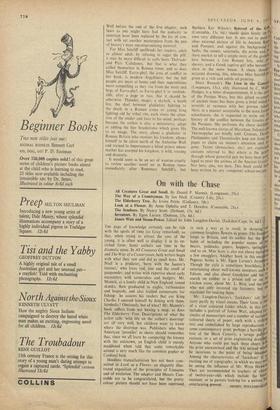On with the Chase
All Creatures Great and Small. By Daniel P. Mannix. (Longmans, 25s.) The Way of a Countryman. By Ian Niall. (Country Life, 25s.) The Elderberry Tree. By Irvine Petite. (Gollancz, 18s.) Look at a Flower. By Anne Ophelia and T. Dowden. (Constable, 21s.) The Seashore. By Nancy Scott. (Dobson, 13s. 6d.) Inventors. By Egon Larsen. (Dobson, I 3s. 6d.) James Watt and Steam-Power. Edited by John Langdon-Davies. (Jackdaw/Cape, 9s. 6d.)
Tae page of knowledge certainly can .be rich with the spoils of time (as Gray remarked), so that, when trying to attract the eyes of the young, it is often well to display it in its en- riched form. Some authors use time in the dramatic sense. In All Creatures Great and Small and The Way of a Countryman, both writers begin with what they saw and did as small boys. Mr. Niall is a predator, 'born with the hunter's instinct,' who loves rod, line and the smell of gunpowder. and writes with expertise about early encounters with corncrakes and badgers. Mr. Mannix, as a lonely child in New England, tamed skunks, then graduated to eagles, rattlesnakes and leopards, and also trained cormorants for fishing: he assures his readers that our King Charles I amused himself by fishing with them. Symbolic? Obviously, but of what? Mr. Mannix's book suffers from not having a map, as does The Elderberry Tree. Descriptions of what the jacket calls 'wild life on the author's doorstep' are all very well, but children want to know where the doorstep was. Publishers who buy American 'juveniles' as sheets should remember that, since we all learn by comparing the known with the unknown, an English child is merely maddened when told that some remarkable animal is very much like the common gopher or Cardinal bird.
Heedless transatlanticism has not been com- mitted in Look at a Flower, an elegantly illus- trated exposition of the principles of Linnaeus and of evolution. The adaptor and Messrs. Con- stable are to be congratulated, but the pretty colour picture should not have been contrived in such a way as to result in showing common foxglove flowers as green. The sea 1`, keeps to Britain, and its author has the habit of including the popular names of ,ber. beasts, `piddocks, gapers, hoppers, springtal and so on. Miss Scott is also not above includi a few smugglers. Another book in this excglie° Pegasus Series is Mr. Egon Larsen's lime (1' Though the style is sometimes breathless, entertaining about well-known inventors su Edison, and also about Goodyear and his re. search on rubber in a prison cell or on the kitchen stove, about Mr. L. Biro, and the 111e", who not only invented zip fasteners. but the machines for making them. Mr. Langdon-Davies's 'Jackdaws' tell their story partly by visual means. Their form is that of a stout coloured folder which, in this case' includes a portrait of James Watt, adapted fac; similes of manuscripts and a number of various" coloured sheets of paper, each with a striking( text and embellished by large reproductions ,t) some contemporary print, perhaps a horrific:131; ture of the Black Country, a savage polOc° cartoon, or a set of prim engineering draw% Anyone who could put back these sheets WI,A the print unexamined and the text unread weal" be incurious to the point of being inhumani Among the characteristics of 'Jackdaws' is sn exciting use of typography, in which we may 0d. be seeing the influence of Mr. Wren HoWar. They are recommended to teachers of class,
:, of twelve-year-olds which include the book` resistant, or to parents looking for a serious bu
a


































 Previous page
Previous page